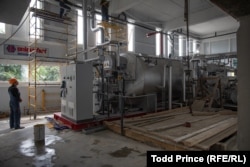ZHYTOMYR, Ukraine -- A five-minute drive from the center of Zhytomyr, a city 140 kilometers west of Kyiv, local and foreign officials gathered on November 18 to celebrate the opening of a new plant to supply heat and hot water to dozens of nearby apartment buildings.
The $10 million project, financed largely through grants and cheap loans from Western financial institutions and the Swiss government, looks unremarkable from the outside: It could easily be mistaken for a simple warehouse were it not for the slender gray smokestack jutting toward the sky.
But inside the box-like structure, wood chips will be used for the first time by the city as a fuel source to keep households warm as Zhytomyr seeks to cut back on the consumption of natural gas, a commodity that has been at the heart of some of Ukraine’s biggest domestic and foreign struggles.
The project is the first of five biomass-fueled power plants the city plans to launch, Mayor Serhiy Sukhomlyn told the audience.
Together, they will cut the amount of natural gas consumed by the city’s heating company by as much as 70 percent, he said.
Ukraine’s reliance on natural gas imports to heat its homes, schools, hospitals, and industrial facilities has been a noose around its neck since the country achieved independence from the Soviet Union 30 years ago, providing Russia with a powerful lever to keep Kyiv in its sphere of influence.
The nation is being reminded of that once again as natural gas prices surge to record highs ahead of the winter season, squeezing state budget revenues and raising the risk of an energy crisis in the coming months.
According to energy experts and officials such as Sukhomlyn, what’s happening in Zhytomyr shows that Ukraine could substantially reduce its use of natural gas for heating by tapping its enormous resources of biomass, such as wood and plant waste.
“We hope that Zhytomyr will become an inspiration for many other cities in Ukraine,” Claude Wild, the Swiss ambassador to Ukraine, said at the ceremony.
Advocates say biomass is one of a number of tools Kyiv could use to clear a pathway to “gas independence,” along with increased energy efficiency and domestic natural gas production.
They lament that the nation’s centralized heating sector – which accounts for about one-fifth of all gas consumption in Ukraine -- has failed to make much headway to date.
Government subsidies and a lack of competition in the heating sector are partially to blame, experts say.
Kyrylo Tomlyak, the manager of the European Bank of Reconstruction and Development’s (EBRD) bioenergy program in Ukraine, said the transition is a “difficult process” but one that “can and must be done in other cities.”
Home And Hearth
Ukraine consumes about 30 billion cubic meters (bcm) of natural gas a year, largely for heating and industrial purposes, but can only cover two-thirds of its needs from domestic production.
The remaining 10 bcm must be imported – indirectly from Russia -- costing the cash-strapped nation billions of dollars a year.
Municipal-owned district heating companies -- which use gas-fired boilers or CHPs to produce heat -- consume about 6 bcm to supply high-rise apartment buildings, state-run institutions such as schools and hospitals, and religious organizations.
Experts say these heating companies are particularly ripe for a transition to locally sourced biomass, which is economically competitive with natural gas, especially in today’s high price environment.
Yuriy Vitrenko, the new chief executive officer of Naftogaz, Ukraine’s state-owned gas giant and the chief supplier to district heating companies, told RFE/RL during a visit to Washington in June that he would push for their transition to biomass.
“As a national company it's our job to solve national problems,” Vitrenko said. “So we should be driving this change to make [heating companies] more energy efficient, to enable them to switch from gas to biomass.”
Biomass is not only a cleaner, renewable fuel, its wider use would also create local jobs and keep cash in the country, said Tomlyak of the EBRD, which has funded several biomass projects in Ukraine including the new plant in Zhytomyr.
Tomlyak said forecasts show Ukraine will have to spend at least $100 billion on hydrocarbon imports over the next three decades if it does not take any additional steps to curtail consumption, including through bioenergy substitution.
“In the long-term perspective, it is more profitable for Ukraine to invest in bioenergy solutions and have energy independence and security,” he said.
Self-sufficiency in energy is particularly crucial for Ukraine in light of its severely strained relations with Russia, which seized the Crimean Peninsula in March 2014 and backs separatists who have controlled parts of the industrial Donbas region since the start of a war against Kyiv’s forces the following month.
Many other countries are seeking to increase their use of biomass.
At the UN climate conference that it hosted in Glasgow this month, the United Kingdom said it would publish its biomass strategy next year.
However, there are hurdles to such ambitions in Ukraine.
Concerned about the potential for popular discontent and the need for stability, the country still regulates the price of gas sold to district heating companies, leaving them with little incentive to invest in alternative sources or energy efficiency.
District heating companies are paying about $280 for 1000 cubic meters of natural gas compared with spot market prices of around $1,100.
Industrial enterprises and some budget organizations like hospitals pay market prices for natural gas and, as a result, have transitioned much quicker to biomass.
Kernel Holding, one of Ukraine’s largest agricultural companies, has been investing hundreds of millions of dollars to build CHPs that burn sunflower seed shells to generate energy.
Biomass now accounts for 9 percent of Ukraine’s total heat production, with natural gas making up 80 percent and coal the rest, according to Heorhiy Heletuha, the head of the Bioenergy Association of Ukraine.
Heletuha estimates that biomass, such as wood chips and sunflower seed shells, already substitutes the equivalent of 4bcm of natural gas a year. Industry accounts for the lion’s share of those savings.
It Ain't Easy
Prices for biomass, especially that which can be processed into pellets for long-distance transport, are tied to the price of natural gas, said Roman Shved, the chief executive officer of Ukrteplo, a leading biomass operator.
When natural gas prices rise, demand for biomass increases as a cheaper alternative, pushing its price higher.
That can lead to a situation in which biomass is cheaper on the open market than natural gas, but is still more expensive than Ukraine’s subsidized gas price, making its use by district heating companies uneconomical.
“It is not easy to do business in that environment,” Shved told RFE/RL. “It is ironic because we have a lot of biomass that could be used but isn’t because of [government] policy.”
He said Ukrteplo this year pulled out of its investment in a wood chip-fueled boiler in Slavutych, a city in northern Ukraine, because it was not paid in full for the heat it had supplied to the district heating company.
Ukrteplo’s fate in Slavutych highlights another major problem with the district heating industry’s slow transition to biomass – a lack of money.
District heating companies typically own gas-fired boilers and the hot water pipeline network that connects to buildings.
Their tariffs are set by local governments and generally kept low, starving the companies of cash.
As a result, they have historically struggled not just to reinvest in new infrastructure, but even to pay Naftogaz and independent suppliers of heat.
District heating companies owed Naftogaz more than $1.5 billion as of the end of 2020, crimping the state-owned company’s ability to reinvest in more gas production and help end the nation’s import dependence.
In what may be a reflection of its new strategy toward district heating companies, Naftogaz has recently taken over management of several of them, giving the state-owned gas company more influence over their possible transition to biomass.
Shved said his company learned a tough lesson and will no longer develop any projects in a city where it cannot manage the local heating network and directly receive payments from households.
Heletuha of the Bioenergy Association said Ukraine needs to pass legislation to ensure fair competition in the district heating sector. He said district heating companies effectively operate as monopolies and can block access to the network to private firms seeking to supply heat at a cheaper price.
Tomliak said it can be tough for private companies seeking to invest in the district heating industry to raise cheap capital because of the regulatory risks involved, including the unpredictable outlook for heating prices.
Ukrteplo’s former wood chip-fired boiler in Slavutych is not operating this year despite the high price for natural gas.
However, Ukrteplo is building several wood chip-fired boilers now in Rivne, where it manages the city’s heating network. Shved said he expects the projects will cut natural gas consumption for central heating in the city by half.
For logistical reasons, the transition to biomass is not viable in some districts, particularly those in city centers, Shved and Tomlyak said.
There may not be enough warehouse space to store wood chips or sunflower plant waste, and the trucks needed to haul it could cause congestion, among other problems.
Shved said he considers a 50 percent substitution rate of biomass for natural gas feasible at most district heating companies, implying potential future savings of about 3 bcm a year, the equivalent of nearly one-third of Ukraine’s natural gas imports.
Biomethane Law
Development of wood chip-fired heating plants in Zhytomyr, Slavutych, and Rivne is not a coincidence. All are located in regions of Ukraine blessed with significant forest acreage.
Zhytomyr possesses the most forest resources of any region in Ukraine, making wood chip heating plants very economical compared to natural gas.
But Ukraine’s biofuel wealth really lies in its agricultural sector, experts said.
The nation’s agricultural sector has been prospering over the past two decades as investment pours into its fertile fields, creating ever more solid biomass.
Ukraine is the world’s largest producer of sunflowers, whose waste can be both combusted for heat production or turned into biogas -- a mixture of methane and carbon dioxide -- for electricity production.
The country is also one of the largest producers of wheat.
Heletuha said he sees straw becoming the dominant biomass source in Ukraine in the coming years and forecasts biomass replacing another 5 bcm of natural gas consumption in Ukraine by 2030.
Zhytomyr is already warming two schools with straw, Sukhomlyn said.
The agriculture sector may also become a key source of biomethane, a renewable energy source almost identical to natural gas that is derived from removing the carbon dioxide from biogas.
Ukraine last month passed a law defining biomethane, opening the door for investors to finally begin producing and transporting it through the nation’s pipeline system.
Ukraine could realistically produce 5 to 6 bcm of biomethane in the next 15 years, with 1 bcm already possible by 2025, Tomlyak said.
The 2025 target would require as much as $2 billion in investment, but Tomlyak said the energy shock this year may serve as a catalyst to get the funds flowing.












